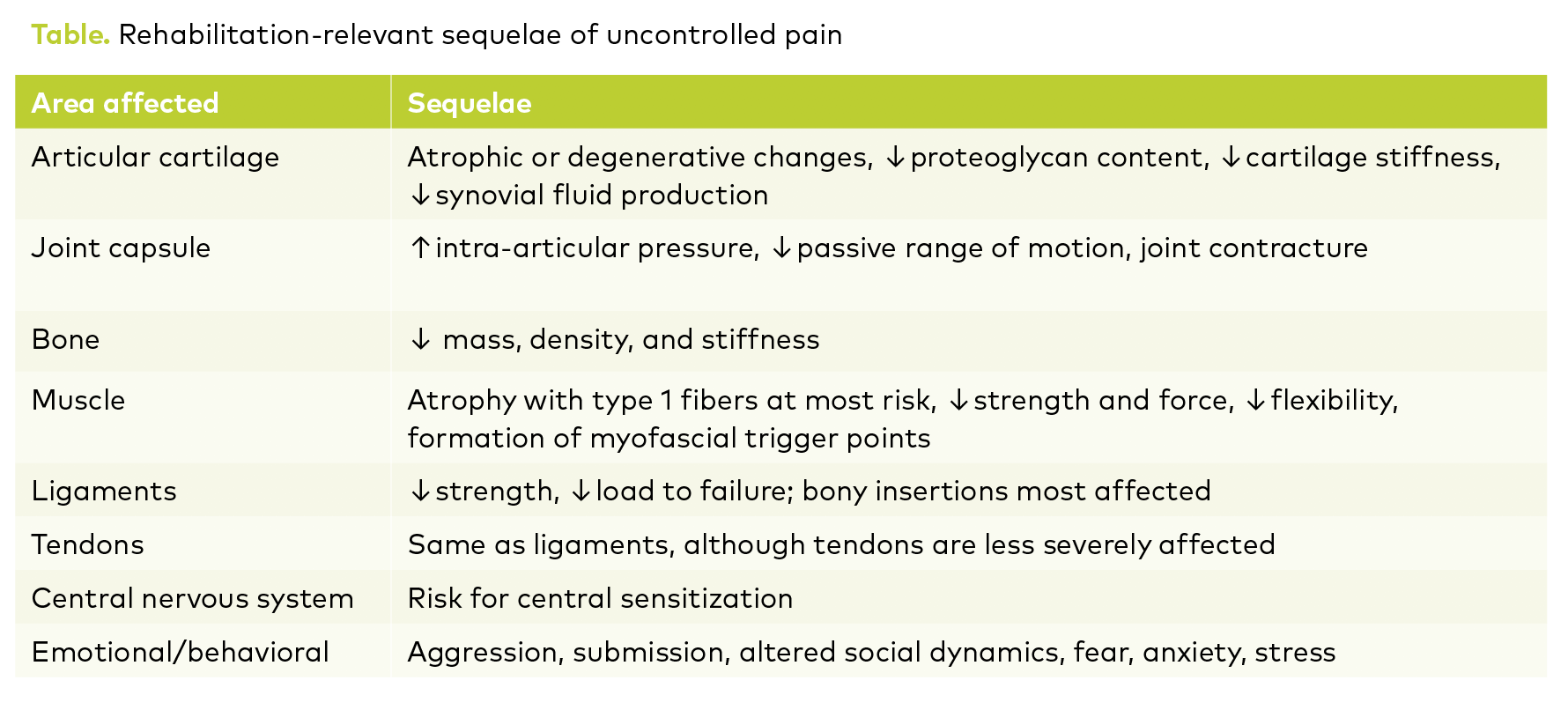
A look at the causes and effects of pain, and how to assess your patients before beginning rehab.
Veterinary physical rehabilitation is most effective when a multimodal approach is used. Arguably, the most important aspect of multimodal management for these patients is proper pain control. Rehabilitation will be counterproductive if the patient’s pain is not identified and managed appropriately.1 Localizing, assessing, and managing pain are imperative to improve patient comfort and compliance, both of which are paramount for successful rehabilitation.
Pain versus nociception
Pain is a complex, often under-recognized phenomenon that includes both emotional and sensory components. Under the umbrella of pain lies nociception, which is the neural processing of a noxious stimulus. Nociception does not require consciousness. For example, a patient anesthetized with a hypnotic agent, such as propofol, will still exhibit a physiologic response to painful stimuli.
Pain is personal to every patient and, therefore, infinitely complicated. Our conscious perception of pain is subjective and “can be experienced even in the absence of obvious external noxious stimulation and…modified by behavioral experiences including fear, memory, and stress.”2
Understanding the uniqueness of each patient’s pain enhances the practitioner’s ability to assess the animal accurately and guide treatment. It is important to recognize that pain is multi-dimensional, encompassing not only what the patient feels but also how it makes them feel.3
Physiologic and psychological outcomes of pain
Uncontrolled pain has myriad, often unrecognized consequences, the full breadth of which are outside the scope of this article. This article focuses on the deleterious effects of neurologic and musculoskeletal pain, specifically pain leading to full or partial disuse of the limbs. One of the most common manifestations of pain seen in rehabilitation medicine is lameness, and this aversion or inability to use a limb at full function can lead quickly to multi-system changes (Table).

Changes to muscle
Changes to muscle secondary to disuse can often be appreciated easily on physical exam or even visualized from a distance. Muscle atrophy occurs quickly and is easily palpable; type 1 muscle fibers, which are important for maintaining posture, are most at risk. Decreased strength and loss of muscle force can also be appreciated.4 The latter is suspected to be secondary to a cellular component and not entirely explained by the atrophy itself.4 Flexibility deficits can occur if muscles are immobilized in a shortened position, resulting in decreased muscle fiber length.4 Altered biomechanics can cause a sustained low-level muscle contraction, which is thought to promote the formation of myofascial trigger points.5
Changes to tendons, ligament, and bones
When tendons and ligaments are insufficiently loaded their mechanical integrity declines, with bony insertions particularly affected.4 A decrease in stiffness (the tissue’s ability to resist deformation) occurs. There is also a decrease in maximum failure load, which is the point at which a force can cause complete breakdown of the tissue. Although tendons and ligaments are both at risk for similar detrimental effects, tendons are less severely affected.4
When bones are deprived of stress, their mass, density, and stiffness decrease.4Increased bone resorption causes bone atrophy. The distal-most weight-bearing bones are at the highest risk for bone loss.4
Changes to articular cartilage
The articular cartilage will atrophy and/or experience degenerative changes when deprived of stress or immobilized. In addition, synovial fluid production decreases, resulting in impaired nutrient delivery to the cartilage. Production of proteoglycans, a component of synovial fluid that aids cartilage lubrication, also decreases, potentially reducing cartilage stiffness. The joint capsule itself is also harmed by disuse. Contracture can occur causing increased intra-articular pressure and decreased passive range of motion.4
Other types of changes
The experience of pain is stressful and affects not only a focal area but the entire body. The biologic stress response has many systemic effects, including hematologic, immunologic, and metabolic changes.6 Significant pain that is left untreated can lead to central sensitization, a dysfunction in the ability of the central nervous system to process pain that can be refractory to many common analgesics. The behavioral and emotional effects of pain should not be overlooked. Clients may notice a variety of behavioral changes in their pet, including becoming more withdrawn, anxious, aggressive, or submissive.7
Assessing pain
Because the behaviors associated with pain can be nebulous, veterinary professionals must continually develop and sharpen their ability to interpret nonverbal pain cues in their patients. A seemingly innocuous observation from a client, such as reclusiveness, can sometimes signal a subclinical problem.
The patient should be assessed with a thorough examination that includes observing the patient both in motion and at rest. Look for abnormal weight distribution, lameness, difficulty with postural transitions, or the inability to relax. Does the patient have an altered or exaggerated response to palpation? Are they tense or guarding when a specific area is examined? Is there evidence of excessive grooming or a cessation of grooming?
While some pets vocalize when a focal source of pain is discovered, others show their discomfort more subtly. In my experience, patients undergoing a painful examination may exhibit stress behaviors, such as a change in pupil size, lip licking, or yawning. Grimace scales, which use facial expressions, orbital tightening, and ear position as indicators, have been developed for measuring pain in several species.
The client should be interviewed about their pet’s behavior at home, such as difficulty eliminating, changes in food or water consumption, changes in demeanor or family interactions, and other alterations to their activities of daily living.
Pain scoring
Because pain is considered the fourth vital sign (behind heart rate, respiratory rate, and body temperature), the American Animal Hospital Association advocates for pain scoring to be routine and ubiquitous.8 Although there is no one-size-fits-all pain assessment tool, several standardized subjective and objective tools are available.7Scoring systems vary widely depending on how the data are obtained (visual vs numeric), the patient’s species, or the type of pain experienced (adaptive vs maladaptive).
It is best practice to choose a single pain scoring system for use throughout your hospital. The chosen system should be convenient and uncomplicated, with good inter-rater reliability. An ideal pain scale is multidimensional, includes several aspects of pain intensity and pain-related disability,9 and evaluates the animal during activities of daily living. Using a clinically tested and validated scoring system strengthens confidence in the results. For rehab patients, I find it helpful to have the client also complete the same questionnaire for comparison, with both completed at regular, predetermined intervals. This allows for examination of the owner’s impressions in the home environment and can further guide treatment decisions.
Conclusion
Pain in veterinary patients can be difficult to assess. Because unabated pain can have insidious consequences, we must be vigilant pain investigators before beginning a rehabilitation program. Using standardized pain assessment and scoring methods allows the practitioner to devise.a pain management program that can improve the patient’s physiologic and psychological health and thus improve compliance with the rehabilitation program leading to a more successful outcome.
Author: Ashleigh V. Fairfield, LVT, CCRP, VTS (Physical Rehabilitation)
Link: https://www.dvm360.com/view/the-importance-of-pain-assessment-in-rehabilitation-patients with references


